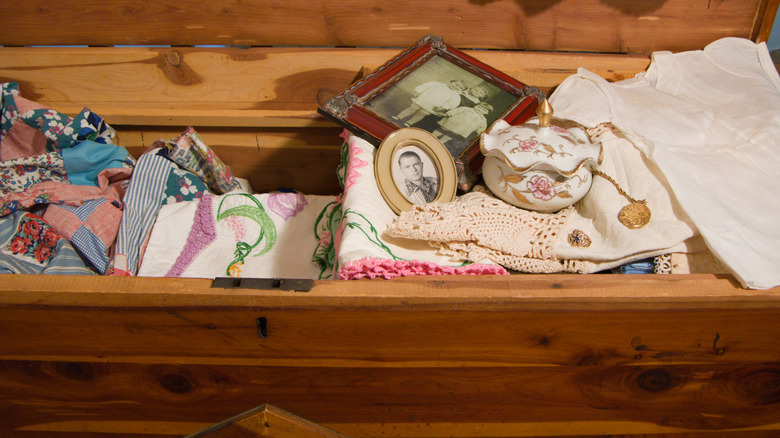Is Your Lane Cedar Chest Worth Anything Today? Here's How To Find Out
Whether you were gifted it to put your hopes and dreams into or stumbled across it at an estate auction, a Lane cedar chest offers an overwhelming feeling of American nostalgia. As a staple in homes since the early 20th century, Lane cedar chests are timeless symbols of artisan craftsmanship. The brand began producing them in 1912 until filing for bankruptcy in 2001, meaning you can't pick up a new one. Although the Lane company crafted other types of furniture, the cedar chest remained its cornerstone. Because Lane cedar chests are excellent examples of high-quality furniture, they've been passed down for generations. Knowing what your cedar chest is worth comes down to a few factors like age, condition, size, and special features. We did some detective work to learn what to look for to get an estimated value of your Lane cedar chest.
In 1920, Lane started the Girl Graduate Plan, which was a decades-long marketing plan that offered an estimated 27 million miniature cedar chests to graduating high school girls. And if you're one of them, yours could be worth something, too. According to experts, the earliest full-sized Lane chests are valued at as much as $3,000 or more, while late-gen mass-produced editions can fetch up to $500. Prices are also dictated by demand, and right now seems to be that time for Lane cedar chests as mid-century modern decor continues to dominate our home design trends.
How to find out what your Lane cedar chest is worth
Lane design elements have changed over time, making some styles and sizes more valuable than others. Standard chests were fairly large at 48 inches high, but there were also smaller jewelry chests and larger blanket chests available. Regardless of the exact dimensions, the interior sizes of every Lane cedar chest offered copious amounts of storage.
One of the first steps to finding out how much your Lane cedar chest is worth is knowing how old it is. Find the serial number and read the numbers backward. For example, if the number is 174101, the production date is Oct. 14, 1971. If, for some reason, your cedar chest doesn't have a serial number, check the hardware. Brass signals it was made before WWI, while steel means it was likely constructed no later than the 1950s. If yours has aluminum hardware, then it was made during the 1960s or later. You can also look for branding or patent labels. Lane cedar chests made between 1912 and 1936 will have a "Made by Lane in Altavista, VA" logo.
As a general rule, the value of the chest increases with age and depends heavily on the condition of the piece. Keep an eye out for any inconspicuous scratches, cracks, or damage, and make sure to use proper methods to clean cedar furniture if it needs freshening up. Some experts say it's important for the chest to have its original cedar smell, but you can always refresh with cedar chips. If yours has seen its share of better days, there are plenty of ways to refurbish your wood furniture.

